County Stuck in Orange As Average Daily Case Count Averages Rise
As Dallas ISD begins phasing in on-campus instruction and county daily cases rose on average last week, public health experts are carefully watching for next steps. Here are today’s bullet points:
- County stuck in orange as average daily case count averages rise;
- Dallas County Elections awarded $15 million grant;
- Abbott announces telehealth agreement and rental assistance.
County Stuck in Orange As Average Daily Case Count Averages Rise
A total of 1,749 new confirmed cases of the novel coronavirus were reported by Dallas County health officials between Friday and Sunday, and an additional 46 probable cases were reported, along with 17 deaths, bringing the county’s total confirmed case count up to 81,175 including 1,020 confirmed deaths.
For reference, last Sunday, the total case count was 77,889, and 995 deaths.
On Friday, the county reported 1,179 confirmed cases and 11 confirmed deaths (with 295 were from the month of September, and two additional probable cases for a total of 1,181); on Saturday, 373 confirmed cases and two confirmed deaths (with 202 cases from September, and an additional 42 probable cases for a total of 415); and on Sunday, 197 confirmed cases and four deaths (with all coming from September, and two additional probable cases for a total of 199).
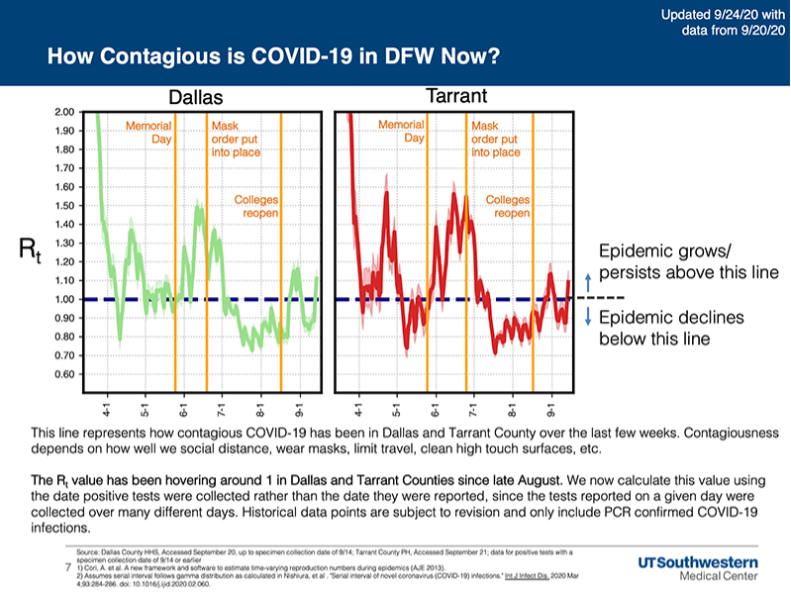
“The numbers from the just ending CDC week are concerning as the average number of cases per day has climbed for the first time in several weeks. The number of school-aged children diagnosed with COVID-19 has increased from the previous week, and our positivity rate, which had been going down for several weeks, has now shot back up to 11.9%,” said Dallas County Judge Clay Jenkins. “The County will remain in ‘orange’ at this time but it is very important that with some of the indicators now going in the wrong direction, that we focus on one hundred percent mask compliance when outside of our nuclear family.”
Among the dead are a Dallas man in his 30s, a Dallas man in his 40s, two Dallas men in their 50s, a Dallas woman in her 50s, two Dallas men in their 60s (one was found dead in his home), a Dallas man in his 70s, a Cedar Hill man in his 70s, an Irving woman in her 70s, a Dallas man in his 80s, a Rowlett man in his 80s, a Dallas woman in her 90s who died in a hospital emergency room, a Dallas woman in her 90s who was found dead in her home and had no underlying health conditions, and a DeSoto woman in her 90s who died in a hospital ER. All, unless noted, had underlying high-risk health conditions.
Additionally, two died in local long-term care facilities – a woman in her 50s who lived in a Carrollton facility, and a man in his 60s who lived at a DeSoto facility.
The county said that the number of COVID-19 hospitalizations Friday was 341 patients. Emergency room visits for COVID-19 symptoms represented about 14% of all ER visits, according to information reported to the North Central Texas Trauma Regional Advisory Council.
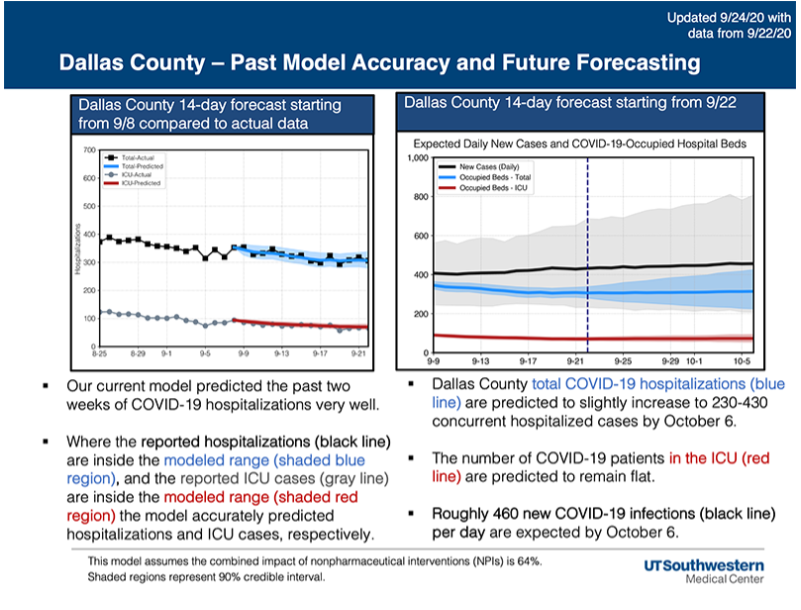
UT Southwestern’s latest forecast projects that by Oct. 6, Dallas County hospitals could see concurrent hospitalizations rise to between 230 and 430 cases, with roughly 460 new cases per day on average. The new modeling does take into account the return to school campuses.
In the county’s Sept. 25 aggregate report, most confirmed cases continue to be between the ages of 18 and 60, with the 18-40 age group accounting for 47% of the cases, and the 41-64 age group accounting for another 34% of the total cases.
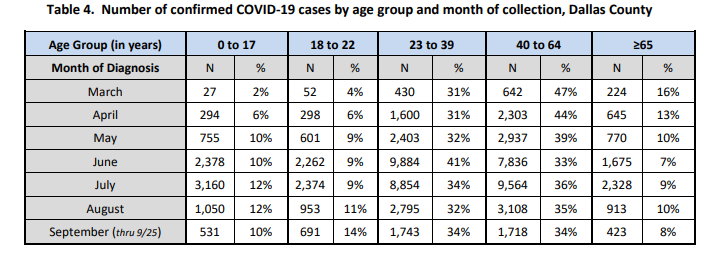
The percentage of cases occurring in young adults aged 18 to 22 years has increased to 14% in September to date. A provisional total of 225 confirmed and probable COVID-19 cases were diagnosed in school-aged children (5 to 17 years) during CDC week 38, an increase from the previous week for this age group.
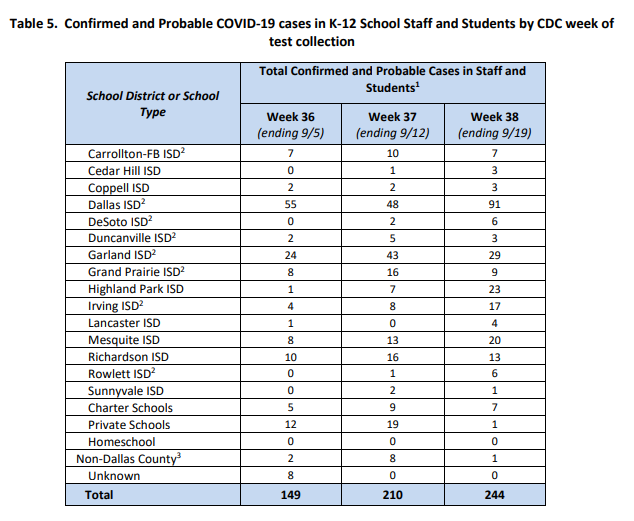
According to trackers provided by Dallas ISD and Highland Park ISD, cases of COVID-19 are cropping up at schools. Dallas ISD, who begins phasing in a return to on-campus instruction today with pre-K, kindergarten, sixth grade, and ninth grade students reporting to campus, has 16 total cases in the district so far, with the majority being staff (there are seven student cases).
Highland Park ISD, who has offered on-campus instruction for a longer period of time, is reporting a total of 35 cases, with the bulk being Highland Park High School students at 25 cases. Of those cases, 10 students and two staff members have been deemed well enough to return to their campuses.
Close contact or community transmission continues to be the biggest risk factor for contracting COVID-19, accounting for almost 94% of all cases.
Of the testing done, positive cases accounted for 11.9% as of Sept. 19, with 626 positives coming from 5,256 tests. Testing for the week prior found that positive cases accounted for 10% of all testing.
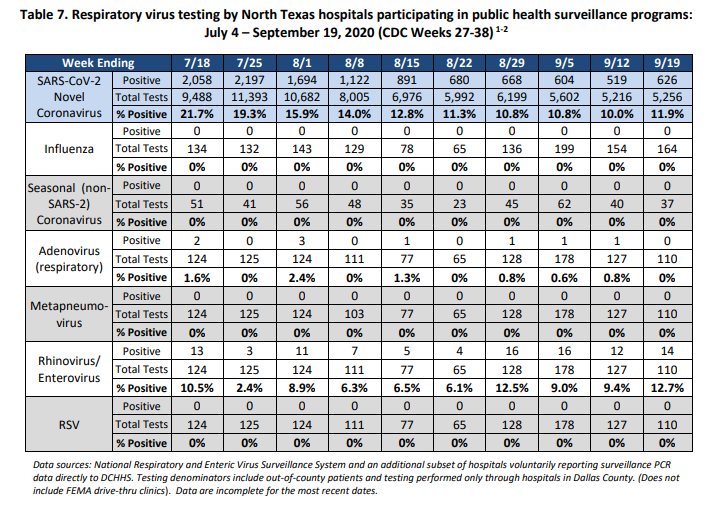
Ten percent of all cases ended up hospitalized – 24% ended up in intensive care, and 13% ended up on a ventilator.
In a city-by-city breakdown, Dallas still comes in with the highest number of cases – 42,122 confirmed cases and 1,971 probable cases. Highland Park has 85 confirmed cases (up from 79 last week) and another 30 probable cases, and University Park has 228 confirmed cases (up from 188), and 232 probable cases.
Dallas County Elections Awarded $15 Million Grant

The Dallas County Elections Department was awarded a $15,130,433 grant from the Center for Tech and Civic Life to make sure resources and staffing are available during an historic election year – during a pandemic.
The nonpartisan nonprofit connects elections officials with technology to help them communicate with voters, and in the case of Dallas County, it will also allow officials to hire additional personnel, purchase extra voting and mail ballot sorting equipment, operate more early voting and Election Day polling locations, and ensure that ample stores of sanitation supplies and PPE.
“We know this election will be unlike any other in recent history because of a unique combination of anticipated long lines due to the governor blocking expanded mail-in-voting during the pandemic, the legislature’s elimination of straight-ticket voting, necessity for social distancing due to the pandemic and longer ballots due to the addition of municipal and ISD races and measures,” said Jenkins. “The over $15 million grant from the Center for Tech and Civic Life to our Dallas County Elections Department for this general election acknowledges the challenges we face and provides resources to ensure your vote counts and we have a safe and secure election this November.”
Toni Pippins-Poole, Elections Administrator for Dallas County stated, “The grant from the Center for Tech and Civic Life is an investment in the success of our upcoming election. That success is defined as ensuring that every citizen who is eligible to vote can do so in a safe and secure manner and that their vote is counted. With these additional resources, our team can amplify their efforts to communicate safe voting protocols and opportunities to the public and provide more options for voters throughout Early Voting and on Election Day.”
Abbott Announces Telehealth Agreement, Rental Assistance

Gov. Greg Abbott Friday announced that major health insurers in Texas agreed to continue reimbursing network health care providers for telehealth appointments at the same rate they pay for office visits, through the end of the year.
While the agreement applies only to state-regulated plans, both the Employee Retirement System and the Teacher Retirement System will continue telehealth payment parity through the end of the year as well.
Since the COVID-19 pandemic began, the State of Texas has expanded telehealth options and availability so that Texans can continue to access the health care services they need,” said Abbott. “Millions of Texans have chosen to use telemedicine over the past several months, and this new agreement with Texas network health insurers will help ensure that Texans can continue utilizing telehealth options. I thank the health plans for stepping up to meet the needs of our state during the COVID-19 pandemic.”
Telehealth allows patients to receive health care services in a location separate from their provider through virtual and other technological communications platforms. According to a new study by Accenture, an estimated 4.5 million Texans have begun using virtual healthcare services since the onset of the COVID-19 pandemic.

Abbott also announced Friday that more than $171 million in Coronavirus Aid, Relief, and Economic Security Act funding will be used primarily for targeted rental assistance for people at risk of becoming homeless due to eviction.
The funding will also allow the Supreme Court of Texas, the Office of Court Administration, and the Texas Department of Housing and Community Affairs to work in partnership with local governments and nonprofits and the newly created Texas Eviction Diversion Program to help renters stay in their homes, catch up on missed rental payments, and avoid an eviction on their records.
About $167 million will go to targeted rental assistance, and $4.2 million will go to help the state’s legal aid providers and pro bono lawyers provide legal services to eligible Texans.
“The Texas Eviction Diversion Program is crucial to our state’s response to COVID-19, and it will help many families recover from the impact of the pandemic without the looming threat of eviction,” said Abbott. “This innovative partnership, coupled with the renters assistance provided through CARES Act funding, will strengthen our economic recovery efforts and provide a lifeline to renters and property owners alike.”
“Judges across Texas have a duty to ensure that justice is delivered in a timely, fair, and impartial way. In times like these, sometimes that means that we search for creative ways to meet the needs of landlords and tenants,” said Texas Supreme Court Chief Justice Nathan L. Hecht. “The Texas Judiciary is happy to work with Governor Abbott and the Texas Department of Housing and Community Affairs to provide a way for tenants to stay in their homes and ensure that landlords are made whole.”
“The rental assistance and Texas Eviction Diversion Program will help courts deal with the anticipated deluge of eviction filings by reducing filings and diverting cases to an agreeable solution. Courts have worked hard to maintain access to justice during the pandemic, but we anticipate difficulty with timely handling the large number of eviction cases likely to be filed soon,” said David Slayton, Administrative Director of the Texas Office of Court Administration. “The program announced today by the Governor, TDHCA, the Supreme Court, and OCA will permit courts to focus on those cases that need the most attention and ensure that landlords and tenants are able to resolve their issues timely.”
“The effects of the COVID-19 pandemic have been devastating for many Texans, especially for some of our most vulnerable households,” said Bobby Wilkinson, TDHCA executive director. “TDHCA, along with state leaders and program partners have worked expeditiously to get the CARES Act funds out to those in need, and I believe our efforts can make a difference not only in these particular communities, but throughout the state as we work toward more long-term recovery solutions.









